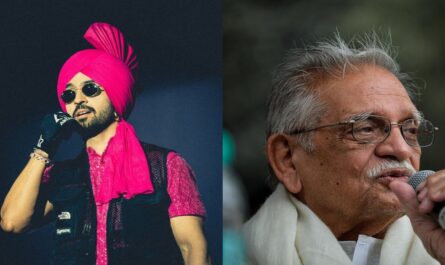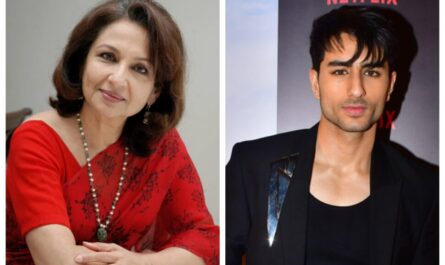Sushmita Sen’s name is synonymous with fearless expression and unapologetic honesty. Beyond her well-known title as a Miss Universe and her celebrated career in Bollywood, Sen has long been recognized for her willingness to speak up on topics that many deemed controversial. In an era when women in the public eye were expected to conform to conservative norms, her candid opinions often put her at odds with mainstream media expectations. In an insightful reflection shared in an interview, Sen recounted a period in the 1990s when her vocal stance on various issues led to a unique form of censorship: she was effectively banned from gracing the covers of entertainment magazines.
The 1990s: A Time of Cultural Conservatism
To truly appreciate the significance of Sen’s experience, one must first understand the cultural climate of the 1990s in India. During that period, societal values were deeply entrenched in conservatism. The public, the media, and even the corporate entities behind popular magazines often upheld a set of unwritten rules about what was considered acceptable for a female celebrity. Women were expected to embody a demure, agreeable persona—one that eschewed the display of strong, independent opinions.
In a time when traditional gender roles were rigorously enforced, the idea of a woman being both a beauty icon and an opinionated individual was seen as a double-edged sword. Outspoken personalities were quickly labeled as “too bold” or even a negative influence on impressionable young minds. It was in this setting that Sen’s forthrightness, far from being celebrated, was met with disapproval. One infamous reaction was the refusal by magazine publishers to feature her on their covers, accompanied by the damning remark: “Don’t get her in front of our kids.”
Censorship and Its Implications on Media Representation
The cover ban imposed on Sushmita Sen was more than a mere editorial decision—it was a stark example of how the media could be used as a tool to enforce conformity. By sidelining her from one of the most visible platforms, the industry attempted to send a message: celebrities who dared to challenge conventional expectations could be sidelined or even ostracized. This action not only affected Sen’s personal image but also had broader implications for how outspoken women were perceived in society.
Sen’s own recollection of the incident provides valuable insight into the mindset of that era. She noted that during the 90s, society operated in a more “closeted” manner. Public discourse was tightly controlled, and any deviation from the norm—especially by a woman—was quickly labeled as inappropriate. For Sen, the consequence of speaking her mind was a direct clash with these societal expectations. The ban was not a commentary on her talent or achievements; rather, it was a punitive measure designed to stifle her independent voice.
This form of censorship was a double bind. On one hand, it discouraged celebrities from expressing their true thoughts, and on the other, it perpetuated the notion that women’s opinions should be moderated to suit public sensibilities. The media, being a powerful force in shaping public discourse, thus played a critical role in reinforcing the idea that certain viewpoints were “too strong” for the general audience—especially for children.
The Bold Stance of a True Icon
In a revealing conversation with a popular film platform, Sen opened up about her experience of being branded as a “bad influence” due to her candidness. She recalled how her unabashed honesty and refusal to conform to the sanitized image expected of a female celebrity led to a series of repercussions. According to Sen, the negative labeling was not a reflection of her character but rather a product of an era that was unready to accept strong-willed women in positions of influence.
While the ban was intended to limit her exposure, Sen’s response was both pragmatic and defiant. She recognized that the freedom to express oneself is an inalienable right, one that should not be compromised even if it means facing backlash. “If you take away my freedom to express myself, what freedom do I really have?” she once remarked. This powerful sentiment encapsulated her resolve: rather than retreating into silence, she chose to refine the manner in which she communicated her opinions.
Over time, Sen acknowledged that there was a learning curve involved in balancing raw honesty with tact. While she never diluted her beliefs, she adapted her style so that her points were articulated in a manner that resonated with a broader audience. In doing so, she not only retained her authenticity but also managed to bridge the gap between being outspoken and being palatable to the public.
This evolution in her communication style serves as a testament to her resilience. It underscores the idea that while the content of one’s opinions is crucial, the manner of their delivery can determine how well they are received. Sen’s journey from being vilified for her directness to eventually being celebrated as a thought leader highlights the transformative power of adapting without compromising one’s core values.
Changing Tides: From Rejection to Resurgence
The narrative of Sushmita Sen is not solely one of struggle; it is equally a story of triumph and reinvention. Despite the challenges she faced in the 90s, her career did not falter. Instead, the seeds of resistance she planted eventually bore fruit in an era that had grown more accepting of diverse opinions.
In recent years, Sen has experienced a remarkable career resurgence, a phenomenon that speaks volumes about the shifting dynamics of the entertainment industry and societal attitudes. The digital age has ushered in platforms where authentic voices can thrive without the constraints of traditional media gatekeeping. Sen’s performances in groundbreaking web series such as Aarya and her daring portrayal of a transgender character in Taali have cemented her status as an icon of modern storytelling. These roles not only showcased her versatility as an actress but also reaffirmed her commitment to pushing boundaries.
The renewed appreciation for Sen’s craft is a direct counterpoint to the earlier era when her opinions were suppressed. Today’s audience, which values authenticity and diversity of thought, has embraced her as a role model. Her story has become an inspiration for a new generation that is less concerned with conforming to archaic norms and more focused on celebrating individuality and free expression.
A Broader Reflection on the Role of Media in Shaping Identity
The saga of Sushmita Sen’s cover ban offers a critical window into how media narratives can shape—and sometimes distort—the public image of a personality. In the 90s, the decision to withhold her from magazine covers was rooted in a broader agenda of social control. It was an attempt to sanitize the image of a woman who dared to speak her mind, thereby upholding a narrow definition of femininity and propriety.
This episode invites us to reflect on the broader implications of media censorship. When influential platforms such as magazines decide which voices are “worthy” of being amplified, they play a pivotal role in defining societal values. By prioritizing conformity over individuality, these platforms risk creating an environment where creativity and honest discourse are stifled.
Sen’s experience is particularly relevant in today’s context, where social media and digital platforms have democratized the dissemination of information. In the current landscape, the authority of traditional media is increasingly being challenged by voices that come directly from the people. The backlash against censorship and the demand for authenticity have paved the way for a more inclusive media environment—one that celebrates rather than suppresses boldness.
Moreover, Sen’s journey underscores the importance of resilience in the face of institutional pushback. It is a reminder that even when established norms are challenged, personal integrity and a commitment to truth can ultimately prevail. Her story is not just about one actress’s battle with censorship; it is a larger commentary on the evolution of free speech in a rapidly changing society.
From Isolation to Inclusivity: The Transformation of Public Discourse
One of the most striking aspects of Sen’s narrative is her observation about how society has evolved over the years. In the conservative climate of the 90s, her unabashed opinions were considered disruptive—so much so that they led to a ban on magazine covers. Today, however, the landscape is markedly different. The modern public is far more receptive to diverse viewpoints, and the media has increasingly become a space for open and unfiltered dialogue.
This transformation is not merely a reflection of changing attitudes; it is also a result of the tireless efforts of trailblazers like Sen who challenged the status quo. By refusing to be silenced, she helped pave the way for a more inclusive environment in which authenticity is celebrated. The shift in public discourse can be seen in the increasing number of women in media and politics who speak their minds without fear of reprisal.
Furthermore, Sen’s story resonates on a global scale. In many parts of the world, women continue to fight against similar stereotypes and restrictions. Her experience serves as a powerful reminder that the struggle for free expression is a universal one. It highlights the need for societies everywhere to reexamine the ways in which traditional norms can hinder progress and suppress individual voices.
As society becomes more interconnected through digital platforms, the exchange of ideas has taken on new dimensions. The rise of social media, podcasts, and independent online publications means that voices once marginalized by mainstream media can now reach vast audiences. In this context, Sen’s evolution from a banned cover girl to a celebrated icon is emblematic of the broader cultural shift towards valuing substance over superficial conformity.
Lessons Learned and the Road Ahead
Reflecting on Sushmita Sen’s journey provides several important lessons. First and foremost, it underscores the importance of preserving one’s right to free speech—even in the face of significant backlash. The decision to express opinions, however controversial they may be, is a fundamental aspect of personal freedom. Sen’s refusal to compromise on this principle, despite the professional setbacks she encountered, is a powerful reminder of the value of authenticity.
Secondly, her experience illustrates that growth often involves a delicate balance between honesty and tact. While the 90s may have punished bluntness, Sen’s evolution in communication shows that it is possible to remain true to one’s convictions while also learning to express them in a manner that fosters understanding rather than alienation. This is a critical skill for anyone navigating the complex landscape of public discourse today.
Finally, the transformation in how the media and society treat outspoken women serves as a beacon of hope for future generations. The barriers that once restricted creative expression are gradually being dismantled, and voices that were once silenced are now being heard loud and clear. In many ways, Sen’s story is not only about personal triumph but also about the progress of society as a whole.
Conclusion: A Legacy of Fearlessness and Resilience
Sushmita Sen’s journey from being banned from magazine covers to becoming a celebrated icon of modern media is a testament to her resilience, adaptability, and unwavering commitment to speaking the truth. Her experience highlights the challenges faced by those who dare to deviate from the norm and the societal shifts that occur when individuals stand firm in their convictions.
In the conservative days of the 1990s, when a woman’s outspokenness was equated with being a bad influence, Sen’s boldness was unfairly criticized and even punished through subtle forms of censorship. Yet, rather than retreating into silence, she chose to refine her approach while never relinquishing her core belief in free expression. Today, as she enjoys renewed success through diverse roles on digital platforms, her legacy serves as a powerful reminder that change is possible when courage meets conviction.
Her story is an inspiration for all those who believe in the importance of individuality and the power of a well-articulated opinion. In a world that is increasingly open to debate and diversity, Sushmita Sen remains a shining example of what it means to challenge societal norms and pave the way for future generations of women who refuse to be boxed in by outdated conventions.
By transforming her own experience into a platform for broader discussions about media censorship and gender norms, Sen has not only redefined her career but also contributed to a cultural dialogue that continues to evolve. Her journey, marked by both struggle and triumph, invites us to celebrate the progress made in the realm of free speech while acknowledging the work that remains.
As we look to the future, the legacy of Sushmita Sen serves as a call to action for media creators, policymakers, and society at large to foster an environment where bold opinions are welcomed rather than suppressed. Her story is a vivid reminder that the power of a single voice—when steadfast and genuine—can challenge entrenched systems and inspire meaningful change.
In celebrating her achievements and recognizing the hurdles she overcame, we honor not just a celebrated actress and former beauty queen but also a woman who dared to redefine the narrative. Sushmita Sen’s journey, full of twists and turns, is a narrative of evolution—a transformation from the isolated days of stringent censorship to an era where diversity of thought is celebrated. It is this evolution that continues to influence the broader landscape of media and public discourse in India and beyond.
Ultimately, Sushmita Sen’s legacy is a powerful testament to the enduring strength of personal conviction and the transformative power of speaking one’s truth. Her journey is a beacon of hope for anyone who has ever felt constrained by societal expectations—a reminder that true freedom lies in the courage to be oneself, regardless of the obstacles in the path.
In recounting her extraordinary experiences—from facing a ban on magazine covers in the restrictive climate of the 90s to embracing a career revival in the age of digital media—we see a portrait of a woman who not only survived adversity but also redefined what it means to be a public figure in a changing world. Sushmita Sen’s story is one of relentless determination, creative evolution, and an unwavering commitment to the principles of free expression. It serves as an inspiring example for future generations who continue to push against the boundaries of convention, ultimately reshaping society for the better.
By embracing her bold persona and refining her method of expression, Sen has not only enriched her own life and career but also left an indelible mark on the cultural fabric of India. Her journey encourages us to challenge outdated norms, celebrate diversity, and uphold the value of authentic communication. As the world moves forward, the lessons learned from her experiences will undoubtedly inspire a new era of creativity, inclusivity, and freedom of expression—a legacy that will continue to resonate for years to come.



